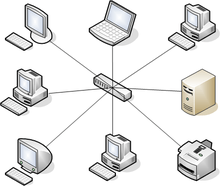Star network


Star networks are one of the computer network topologies. In its simplest form, a star network consists of one central node, typically a switch or hub, which acts as a conduit to transmit messages. In star topology, every node (computer workstation or any other peripheral) is connected to a central node. The switch is the server and the peripherals are the clients.[1]
A star network is an implementation of a Spoke–hub distribution paradigm in computer networks. Thus, the hub and leaf nodes, and the transmission lines between them, form a graph with the topology of a star. Data on a star network passes through the hub, switch, or concentrator before continuing to its destination. The hub, switch, or concentrator manages and controls all functions of the network. It also acts as a repeater for the data flow. This configuration is common with twisted pair cable and optical fibre cable. However, it can also be used with coaxial cable.
The star topology reduces the damage caused by line failure by connecting all of the systems to a central node. When applied to a bus-based network, this central hub rebroadcasts all transmissions received from any peripheral node to all peripheral nodes on the network, sometimes including the originating node. All peripheral nodes may thus communicate with all others by transmitting to, and receiving from, the central node only. The failure of a transmission line linking any peripheral node to the central node will result in the isolation of that peripheral node from all others, but the rest of the systems will be unaffected.[2]
Advantages and disadvantages
- Advantages
- If one node or its connection breaks it doesn’t affect the other computers and their connections.[3]
- Devices can be added or removed without disturbing the network
- Disadvantages
- An expensive network layout to install because of the amount of cables needed[3]
- The central hub is a single point of failure for the network
References
- ↑ Roberts, Lawrence G.; Wessler, Barry D. (1970), "Computer network development to achieve resource sharing", AFIPS '70 (Spring): Proceedings of the May 5–7, 1970, spring joint computer conference, New York, NY, USA: ACM, pp. 543–549, doi:10.1145/1476936.1477020
- ↑ "What is star network? - Definition from WhatIs.com". Searchnetworking.techtarget.com. Retrieved 2014-06-24.
- 1 2 "Teach-ICT OCR GCSE Computing - computer network topologies, bus network, ring network, star network". teach-ict.com. Retrieved 2015-10-15.